Carlton Steamship Co.
![]()
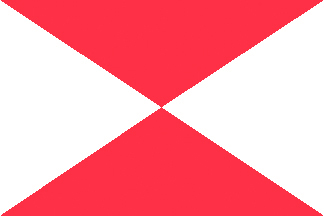 A partnership was formed in 1878 between Ralph Chapman, aged 45 years, and Thomas Robson Miller, both of Gateshead, and having held 64ths earlier in the ownership of the small sailing ship Isabella and others. Chapman had begun in business as a ship’s agent, chandler and manager for other owners as a young man in 1854. Chapman and Miller purchased their first ship on 20th April 1878, a steam tramp named Benton built six years earlier, and shortly afterwards sent her for lengthening by thirty feet to increase her dwt capacity. Castlewood was taken over in July 1878 at the Leslie shipyard in Hebburn but had a brief career for her new owners, as in November 1879 she was wrecked on the island of Gotland off Sweden. Her maiden voyage had been with coal from Tyne Dock to New York, and she was also intended to trade to the Mediterranean and Black Sea and through the Suez Canal to India.
A partnership was formed in 1878 between Ralph Chapman, aged 45 years, and Thomas Robson Miller, both of Gateshead, and having held 64ths earlier in the ownership of the small sailing ship Isabella and others. Chapman had begun in business as a ship’s agent, chandler and manager for other owners as a young man in 1854. Chapman and Miller purchased their first ship on 20th April 1878, a steam tramp named Benton built six years earlier, and shortly afterwards sent her for lengthening by thirty feet to increase her dwt capacity. Castlewood was taken over in July 1878 at the Leslie shipyard in Hebburn but had a brief career for her new owners, as in November 1879 she was wrecked on the island of Gotland off Sweden. Her maiden voyage had been with coal from Tyne Dock to New York, and she was also intended to trade to the Mediterranean and Black Sea and through the Suez Canal to India.
A replacement, Winton, was ready in October 1880 at the Leslie yard, while the rapidly expanding Readhead yard at South Shields delivered Lynton in July 1881. John Readhead expanded into a bigger site in the west of the town, and Lynton was the last vessel launched from the old Lawe yard beside the harbour. She was built of iron and thus hardly corroded at all during her long career of 76 years before being broken up at Hamburg in 1957. The similar Scorton, Carlton, Brampton and Camiola followed from the Readhead yard during the 1880s. A change of shipbuilder was made for the next tramps of 1892/93 to the Wear yard of John Blumer, and chosen to build three tramps, two of them being sisters, but they were to be owned by two new limited liability companies. Carlton Steamship Co. Ltd. was formed on 21st December 1892 and Cambay Steamship Co. Ltd. was formed on 10th August 1892. The principal shareholders in both companies were the Chapman family, their friends and associates.
The previous experience of Ralph Chapman in insuring ships was to stand him in good stead, for he lost four tramps between 1891 and 1893 to marine causes on the long trade routes from North Africa to the U.S.A. with iron ore, and on the ‘Eternal Triangle’ route with Tyne coal to the Mediterranean, returning with grain from the Black Sea. Carlton of 4,220 dwt was delivered from the Ropner yard in Stockton in 1894, and she was one of four owned tramps two years later when the managing partnership became Chapman and Son. Thomas Miller left the area to spend more time in London on business, but the Miller family continued to own shares in the Chapman companies until 1958. Frank Chapman was the son of Ralph Chapman and he had joined the family business in April 1892, having served a four year apprenticeship with Stephens and Mawson of Newcastle, later Stephens Sutton Ltd. The Ropner yard was to deliver a further eight tramps between the years 1898 to 1914, with the last delivered having nearly twice the carrying capacity of the first.
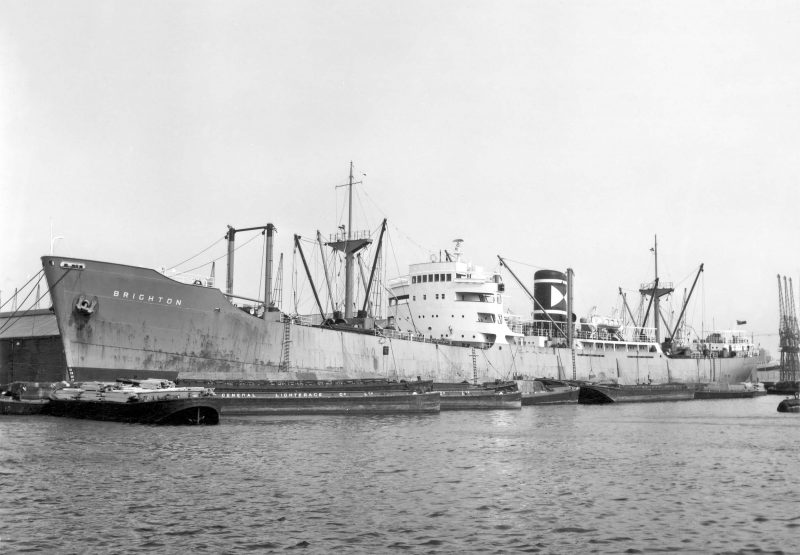
Eight Steam Tramps OF 4,830 to 9,800 DWT
These were Brighton, Floriston, Riverton, Amberton, Carlton, Grainton, Nurtureton and Demeterton, with place names exhausted and replaced with names connected with agricultural and the grain trades. Demeterton was named after the Greek goddess of corn, and Amberton was delivered just after the end of the Boer War in July 1902, and as a consequence was laid up for three months in the Tyne until a charter could be found. Amberton then traded worldwide as the following long voyages show between October 1902 and May 1909:-
- Tyne (coal) sailed on 2.10.1902 for Providence, New Orleans (grain), Hamburg, Tyne
- Barry (coal) sailed on 6.2.1903 for Las Palmas, Bermuda (fo), New Orleans (grain), Le Havre, Tyne
- Tyne (coal) sailed on 7.6.1903 for Delaware, Galveston (wheat), Glasgow
- Glasgow sailed in ballast on 4.10.1903 for Bermuda (fo), New Orleans (grain), Rotterdam, Port Talbot
- Barry (coal) sailed on 2.12.1903 for Hong Kong (ballast), Akyab (rice), Antwerp, Tyne
- Tyne (ballast) sailed on 3.6.1904 for Norfolk (Va) (coal), Cavite, Manila, Calcutta (jute), Dundee, Tyne
- Barry (coal) sailed on 1.12.1904 for Hong Kong (ballast), Rangoon (rice and beans), Antwerp, Tyne
- Tyne (ballast) sailed on 8.6.1905 for Norfolk (Va)(coal), Manila, Calcutta (jute), Dundee, Tyne
- Tyne (ballast) sailed on 3.11.1905 for New York (wheat), Marseille
- (ballast), New Orleans (maize), Harwich, Tyne
- Tyne (ballast) sailed on 5.3.1906 for Baltimore (maize), Amsterdam, Cardiff
- Cardiff (coal) sailed on 5.5.1906 for St. Paul de Loanda (ballast), Tyne. Laid up for three months.
- Tyne (ballast) sailed on 25.10.1906 for New York (wheat), Malta, Piraeus, Volo, Barry
- Barry (coal) sailed on 15.1.1907 for
- Hong Kong, Rangoon (rice), Hamburg, Barry
- Barry (coal) sailed on 11.6.1907 for
- Singapore, Java (sugar), New York, Philadelphia (wheat), Hull
- Tyne (ballast) sailed on 2.12.1907 for Newport News (coal), San Francisco, Tacoma (wheat), Dartmouth (fo), Antwerp, Tyne
- Cardiff (coal) sailed on 23.2.1909 for Montevideo, Bahia Blanca (wheat and oats), London, Tyne
- Newport (coal) sailed on 18.5.1909 for Bahia Blanca (ballast), Durban, Calcutta (general), Colombo (general), Boston, New York, Portland (Me) (wheat), Hull, Tyne
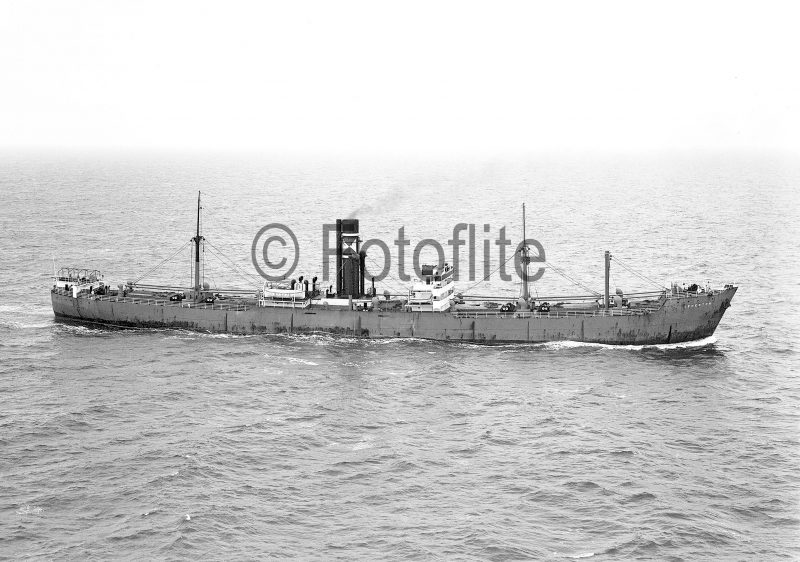
Carlton was delivered next in November 1905 and made her first voyage to the new grain producing areas of the Plate and Argentina in 1910 as the following voyages from her maiden voyage up to June 1912 show:-
- Stockton sailed on 18.11.1905 for the Tyne, New York (wheat), Marseille, Galveston (maize), Avonmouth
- Barry (coal) sailed on 6.7.1906 for Colombo, Singapore (dry-dock), Java (sugar), Suez, New York, New Orleans, Bremerhaven, Tyne
- Barry (coal) sailed on 22.2.1907 for Hong Kong, Karachi (cotton and rape seed), Antwerp, Tyne
- Tyne (ballast) sailed on 24.6.1907 for Java (sugar), Port Said, Delaware, New York, Port Arthur, Galveston (wheat), Antwerp, Barry
- Barry (ballast) sailed on 2.1.1908 for Baltimore (coal), San Francisco, Nanaimo (BC), Moji, Java (sugar), Suez, New York, Newport News (coal), San Francisco, Tacoma (timber), Barry
- Cardiff (coal) sailed on 4.4.1909 for Sabang (Sumatra), Muroran (railway sleepers), Kyuoshu, Redondo (U.S.A.), Seattle (wheat), Belfast, Tyne
- Barry (coal) sailed on 4.3.1910 for Montevideo (ballast), Durban (fo), Karachi (wheat), Manchester
- Newport (coal) sailed on 5.8.1910 for Bahia Blanca (ballast), Durban (fo), Karachi (wheat), Hull, Tyne
- Barry (coal) sailed on 13.1.1911 for Montevideo (ballast), Durban (fo), Karachi (wheat), Antwerp, Tyne
- Barry (coal) sailed on 23.6.1911 for Montevideo (ballast), Durban (fo), Java (sugar), Greenock, Newport
- Newport (coal) sailed on 11.12.1911 for Bahia Blanca (wheat and oats), London, Cardiff
- Cardiff (coal) sailed on 5.6.1912 for Port Said, Karachi (wheat), Dunkirk, Barry
- The new Grainton of 1911 was, as her name implies, to spend most of her time in the grain trades between March 1911 and the outbreak of World War I on the following voyages:-
- Stockton sailed on 12.3.1911 for the Tyne (coal), Bahia Blanca (ballast), Karachi (wheat), Liverpool, Newport
- Newport (coal) sailed on 13.9.1911 for Bahia Blanca (ballast), Durban (fo), Karachi (wheat), Liverpool
- Cardiff (coal) sailed on 2.1.1912 for Montevideo, Bahia Blanca (wheat), Hull, Cardiff
- Cardiff (coal) sailed on 6.6.1912 for Port Said, Karachi (wheat), Manchester, Cardiff
- Cardiff (coal) sailed on 18.9.1912 for Port Said, Karachi (wheat), Hull, Cardiff
- Cardiff (coal) sailed on 7.1.1913 for Port Said, Karachi (wheat), Manchester, Cardiff
- Cardiff (coal) sailed on 5.4.1913 for Port Said, Karachi (wheat), Antwerp, Cardiff
- Cardiff (coal) sailed on 9.8.1913 for Port Sudan, Karachi (wheat), Manchester, Newport
- Newport (coal) sailed on 5.11.1913 for Bahia Blanca (wheat and oats), London, Tyne
- Newport (coal) sailed on 21.2.1914 for Bahia Blanca (wheat and oats), Rotterdam, Tyne
- Tyne (coal) sailed on 13.5.1914 for Marseille, Garrucha (Spain), Philadelphia, New Orleans (grain), Galveston (grain), Tyne
- Tyne (coal) sailed on 6.9.1914 for Marseille, Gibraltar (fo), Sand Key (Florida) (fo), Baltimore (oats), Dunkirk
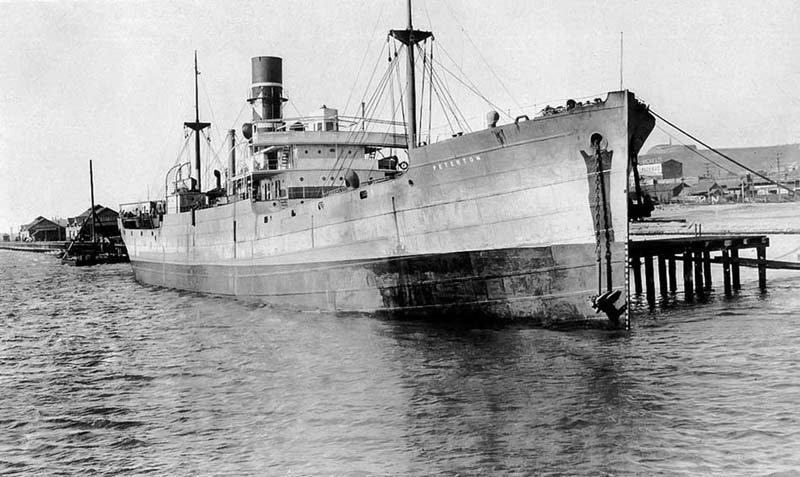
World War I
Grainton was promptly requisitioned by the British Government in Dunkirk Roads on 15th January 1915 after the discharge of her cargo of oats. Floriston had already become a marine casualty by this time, and three more Chapman tramps were to be lost during World War I:-
Floriston stranded on Guyon Island (NS) while on a voyage from Montreal to Avonmouth with grain on 12th October 1914.
Demeterton was captured and sunk by bombs 730 miles NE of Cape Race by the raider Moewe on 13th March 1917.
Amberton was torpedoed on 5th November 1917 and beached at La Calle, 70 miles west of Bizerta, total loss. Refloated 12.1919 and towed to Algiers.
Carlton was torpedoed and sunk on 29th May 1918 270 miles SW of Bishop Rock by U90 while on a voyage from Cardiff to Chile in ballast.
All of the company tramps were requisitioned for use as colliers, supply ships and transports of hay and horses into France. At the end of the war, the surviving tramps were Brighton of 1898, Riverton of 1899, Amberton of 1902, Grainton of 1911, and Nurtureton of 1912. Grainton had grounded in the Suez Canal on 1st August 1916 but was soon refloated, but her run of bad luck continued when she was in collision with the steamer Elsa in the Canada Dock at Liverpool on 26th May 1920, followed by two slight collisions in the Tyne with the steamers Jupiter and Brant County. She also damaged the lighter Marguerite in Antwerp on 16th March 1922, but seventeen months later sailed from Cardiff on 12th August 1923 with coal for Marseille on a long voyage of 243 days that also took her to Montreal, Philadelphia, Bahia Blanca (twice), Genoa, Marseille, Antwerp and the Tyne. Grainton of 1911 was the last of the pre-war tramps when lost after grounding on 31st May 1928 off St. Thomas in the West Indies while on a voyage from Vancouver to Hamburg with grain. She quickly refloated but sank later in 99 feet of water, with the Mate having to take responsibility for her loss as her Master had unfortunately died on the outward passage to Vancouver.
The managing partners were now Frank Chapman and Cuthbert Willan, the latter having joined as an office boy in 1904 and by hard work and application learned the business of tramping and chartering and was made a partner in February 1915. Frank Chapman died in 1933 and Cuthbert Willan carried on as sole partner of Chapman & Son, with Ralph F. Chapman, grandson of the founder, inheriting some £2 million and pursuing a career as an entrepreneur, which included purchasing the London shipbrokers Charles C. Arnell & Co. Ltd.
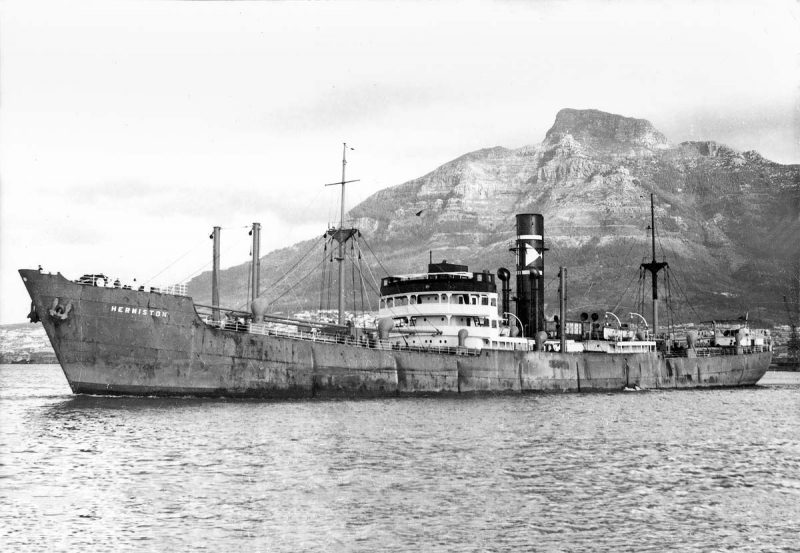
Seven WAR ‘A’ standard tramps were purchased as replacements in 1919, including three of the large 11,050 dwt standard ‘F’ class renamed as Koranton, Mabriton and Linerton. These were six hold open shelterdeckers built with tonnage openings in the side. Linerton was given a cruiser stern by Doxford whereas Koranton and Mabriton had counter sterns by J. L. Thompson. The six hatches were served by a good array of a dozen derricks, and three boilers fed steam to the large triple expansion steam engine to give a reasonable service speed of twelve knots. Linerton was to have the shortest career with the company, sailing on her maiden voyage from the Tyne to Baltimore on 4th November 1919 but only reached as far as Flamborough Head after being disabled by a cracked high pressure cylinder. She was taken in tow by the Tyne tugs George V and Conqueror from Flamborough Head but the tow parted in severe weather off South Shields and she drifted ashore after dragging her anchors. She broke into two and was declared a constructive total loss. The Anglo-Saxon Petroleum Co. Ltd. purchased both halves on the beach, had them refloated and towed to Rotterdam for rejoining and conversion to the tanker Radix, sailing again in October 1921.

Nurtureton of 1912 was sold in 1920 at the height of the post WWI boom for £240,000 to London owners, but was to return to North East Coast ownership in 1922 for J. E. Guthe of West Hartlepool, becoming Siltonhall in 1923 for the West Hartlepool Steam Navigation Co. Ltd. The keel of a 8,870 dwt tramp was laid at the Sunderland yard of Short Brothers during 1921, but the subsequent slump caused her delivery as Carlton to be delayed until April 1924. This was the beginning of a long association between Chapmans and Short Brothers resulting in nineteen tramps being built over a forty year period, and seven were to follow Carlton in the 1920s.
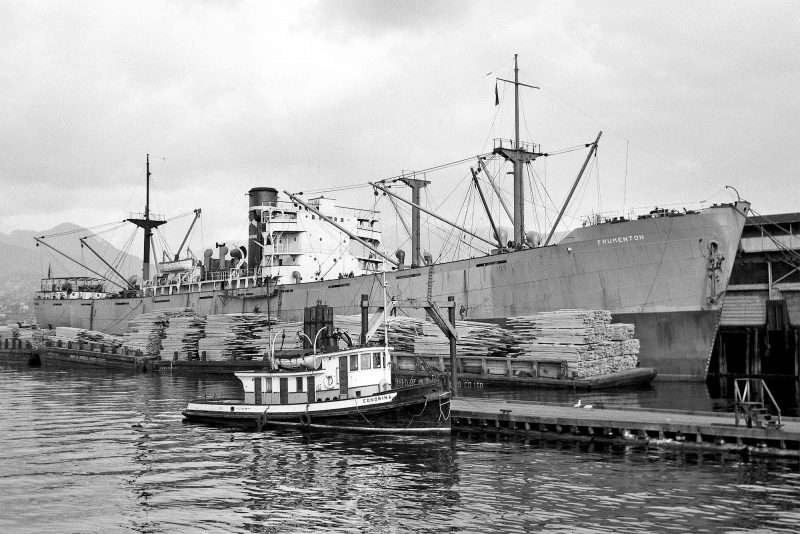
The voyage position of the fleet of the fleet of eight tramps on 29th January 1925 was:-
- Grainton was on a voyage to Australia in ballast to load homewards
- Innerton was on a voyage from Rio de Janeiro to Durban to load coal for Sabang
- Clearton was loading grain at Bahia Blanca
- Peterton was loading grain at Bahia Blanca
- Mabriton was on a voyage to Australia in ballast to load grain homewards
- Tiberton was on a voyage from Galveston to Genoa with grain
- Koranton was on a voyage to Australia in ballast to load grain homewards
- Carlton was on a voyage to Australia in ballast to load grain homewards
- The voyage position of the fleet of nine tramps on 11th March 1927 was similar:-
- Grainton was on a voyage from Bahia Blanca with grain for Rotterdam Ingleton on a voyage from Prince Rupert with timber for Antwerp to discharge
- Clearton was discharging in the Thames
- Peterton was on a voyage from the Tyne with coal to Bahia Blanca to load grain
- Mabriton was homeward bound from Bahia Blanca with grain
- Tiberton was homeward bound from Bahia Blanca with grain
- Koranton was loading grain at Bahia Blanca
- Carlton was loading grain at Bahia Blanca
- Demeterton was on a voyage from the Tyne with coal for the Azores (for orders)
The voyage position of the fleet of ten tramps on 8th February 1928 was similar:-
- Grainton was at Genoa discharging grain
- Innerton was on a voyage to Dunkirk and Leith to discharge
- Clearton was due in the Tyne for a three month refit and special survey
- Peterton was on a voyage from Bahia Blanca to Manchester with grain
- Mabriton was on a voyage to Prince Rupert to load timber
- Tiberton was on a voyage to Bahia Blanca to load grain
- Koranton was loading timber at Vancouver
- Carlton was loading timber at Vancouver
- Demeterton was on a voyage to N.W. Pacific ports to load timber
- Brighton was on a voyage to N.W. Pacific ports to load timber
This left the fleet at fourteen modern steam tramps as chill economic winds set in at the beginning of 1930. However, it was another marine casualty that was to cause anxiety at first. Nurtureton of 1929 ran ashore 1.5 miles east of Dungeness in thick fog on 5th January 1931 while on a voyage from the Tyne to Italy with coal. The rise and fall of the tide broke her back, but her aft end was refloated and beached in the Thames estuary one month later. The fore end proved more stubborn and remained aground for three months until eventually pulled clear, and both halves were then towed to Rotterdam for joining together.

All of the Chapman tramps kept on trading throughout the Depression, although opportunities were taken during the short waits between voyages to fit superheaters to the boilers and poppet valves of the ‘WAR’ standard tramps. The fleet of thirteen tramps on 1st January 1933 was partly waiting for their next coal cargo while laid up in the Tyne, these were Amberton of 1928, Brighton of 1928, Carlton of 1924, Clearton of 1919, Demeterton of 1926, Frumenton of 1930, Grainton of 1929, Innerton of 1919, Koranton of 1919, Mabriton of 1920, Peterton of 1919, Riverton of 1928 and Tiberton of 1920. Carlton left the Tyne with coal for Rio de Janeiro in June 1934 on a long voyage, which took her next to Vancouver, where she had a long wait of one month before she loaded 8,000 tonnes of grain for the U.S. Gulf/North of Cape Hatteras. Amberton was trading at this time with grain homewards from Australia and called in at Dakar and Las Palmas for bunkers and water before discharging at Hull and then on to the Tyne in March 1935.
The rise in freight rates in 1936 brought the company back to Short Brothers for new tonnage, signing a contract in March 1936 for a tramp of 8,120 dwt with a German designed Maierform bow and hull. An increase of half a knot over traditional designs was claimed, although the sharply raked bow would also have come in useful in cutting through the ice in late winter in the St. Lawrence as she made her way upriver for the first cargo of grain of the new season. At Christmas 1936 she was delivered as Generton and left immediately with a full cargo of coal for the Plate, her smaller deadweight capacity making her ideal for this trade. She had two sisters in Hermiston of October 1939 and Scorton of December 1939, with a further sister completed as Barnby for Headlam of Whitby.
World War II
The fleet on the outbreak of World War II on 3rd September 1939 was almost exclusively trading to South Africa returning with cargoes of maize. However, eleven tramps of this fine fleet were sooan to be sent to the bottom of the sea by the enemy:-
- Tiberton mined and sunk on 14th February 1940 on a voyage from Narvik to the Tees with iron ore, four crew lost.
- Riverton sunk at Narvik on 20th April 1940 while loading iron ore.
- Brighton mined and sunk at Dunkirk Anchorage on 6th May 1940 on a voyage from Immingham with coal.
- Clearton torpedoed and sunk on 1st July 1940 by U30 off Ushant on a voyage from Rosario to Liverpool with grain, eight crew lost.
- Mabriton torpedoed and sunk on 25th September 1940 by U32 in mid Atlantic on a voyage from the Tyne to Father Point in the St. Lawrence in Canada in ballast, 12 crew lost.
- Carlton torpedoed and sunk on 20th December 1940 by the Italian submarine Calvi to west of Malin Head on a voyage from Newport to Buenos Aires with coal, 31 crew lost.
- Demeterton shelled and sunk by Scharnhorst in mid Atlantic on a voyage from Liverpool to Halifax (NS) in ballast on 16th March 1941, crew taken prisoner.
- Koranton torpedoed and sunk by U98 in mid Atlantic on a voyage Philadelphia and Halifax (NS) to Hull with pig iron on 27th March 1941, 35 crew lost.
- Frumenton mined and sunk off Orford Ness on 4th March 1942 on a voyage from St. John (NB) to London with wheat.
- Earlston torpedoed and sunk by U334 on 5th July 1942 on a voyage from Iceland to North Russia in infamous convoy PQ17 with Government stores, thirty crew lost.
- Peterton torpedoed and sunk by U109 near the Cape Verde Islands on 17th September 1942 on a voyage from the Thames to Buenos Aires with coal, nine crew lost.
- Innerton sunk as part of the Mulberry Harbour in Normandy on 9th June 1944.
200 Brave Men Died On Company Tramps
42 Men Were Decorated For Bravery
As well as these dreadful losses, other vessels were damaged and four standard type managed tramps were lost in Empire Dew, Empire Cowper, Fort Good Hope, and Empire Curzon. Those killed on Clearton were lost as they lowered a lifeboat, a second torpedo exploding directly on the flimsy boat, while those on Mabriton were in one of the 2 lifeboats which was run down by a rescuing British destroyer. The 4 survivors of Carlton had been drifting for 18 days in a lifeboat in winter Atlantic weather before rescue, and had seen 12 others die alongside them in the lifeboat, with 2 of the 4r survivors having to have their feet amputated because of frostbite. 22 survivors of Peterton were picked up after being adrift in the Second Mate’s boat for 49 days and were landed at Freetown.
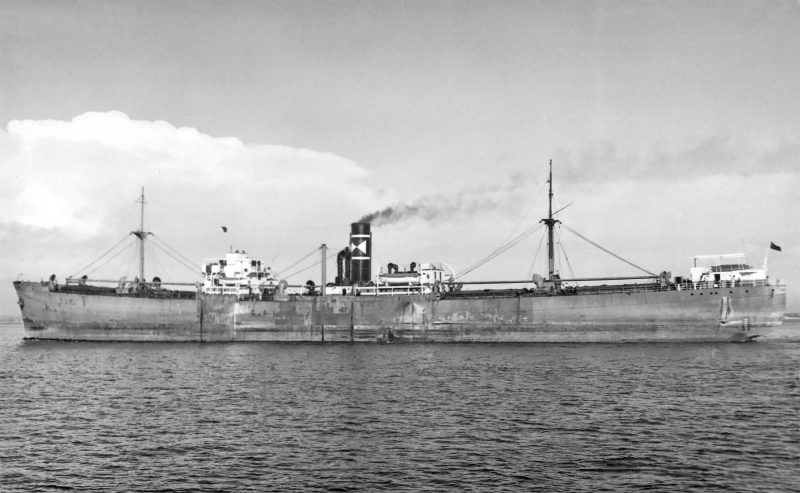


Post World War II Trading
The surviving steam tramps were Amberton, Grainton and Nutureton from the 1920s, the three sisters with Maierform hulls in Generton, Hermiston and Scorton, and nine Burntisland built tramps built during the war. The managed Empire Haven was purchased in 1947 and renamed Clearton, after being fitted with a new Wear built triple expansion steam engine as the original one had been worn out by arduous war service since completion at Hong Kong in 1941. The managed Empire Rival was purchased in 1949 and renamed Amberton to replace her namesake of 1928 that had stranded on 23rd July 1947 on Western Head near Cape Pine (NF) while on a voyage from Quebec to Liverpool with timber and became a total loss.

Brighton of 1943 made the following voyages between 1952 and her sale to Greek owners in 1959:-
- Newport sailed with coal on 12.5.1952 to Buenos Aires, Victoria (Brazil), Tyne
- Tyne sailed with coal on 19.8.1952 to Caibarien (Cuba), Curacao (oil bunkers), Panama, Honolulu, Yokohama, New Westminster, Vancouver, New Westminster, Crofton, Los Angeles, Panama, Southampton, London
- London sailed in ballast on 18.6.1953 to St. Vincent, Rosario, Buenos Aires, Manchester
- Manchester sailed in ballast on 12.9.1953 for Partington, Savona, Casablanca, Dakar, Durban, Dakar, Liverpool
- Liverpool sailed in ballast on 3.2.1954 for St. Vincent, Recife, Curacao (oil bunkers), Panama, Honolulu, Osaka, Yokohama, Vancouver, Los Angeles, Panama, Port of Spain, East London in South Africa, Durban, Dakar, Birkenhead
- Birkenhead sailed in ballast on 7.11.1954 for Mobile (Alabama), Panama, Honolulu, Inchon, Moji, Vancouver, Los Angeles, Panama, Liverpool, Avonmouth
- Avonmouth sailed in ballast on 20.5.1955 for Barry (coal), Philadelphia, Durban, Singapore, Kobe, Nagoya, Yokohama, Britannia Beach (BC), Fraser Mills (BC), New Westminster, Victoria, Crofton, New Westminster, Vancouver, Los Angeles, Panama, London, Immingham, Hartlepool, Manchester.
- Manchester sailed in ballast on 4.3.1956 for Falmouth, San Pedro de Macoris (Dominican Republic), Palenque (Dominican Republic), Colon, Honolulu, Moji, Yokohama, Lautoka (Fiji), Lambasa (Fiji), Lautoka (Fiji), Honolulu, Vancouver, Los Angeles, Colon, Bremen, Las Palmas, Cape Town, Dakar, Leith
- Leith sailed in ballast on 9.2.1957 for Casablanca, Dakar, Cape Town, Monrovia, Dakar, Glasgow
- Glasgow sailed in ballast on 11.5.1957 for Sorel (St. Lawrence), Glasgow, Manchester
- Manchester sailed in ballast on 25.6.1957 for Three Rivers (St. Lawrence), London
- London sailed in ballast on 7.8.1957 for Montreal, Eastham, Manchester
- Manchester sailed in ballast on 13.9.1957 for Everett (Mass.), Rio de Janeiro, Victoria (Brazil), Rijeka, Bermuda, Norfolk (Va), Port of Spain, Montevideo, Bahia Blanca, St. Vincent, Gravesend
- Gravesend sailed in ballast on 13.7.1958 for Hopewell (Va), Tampa, Houston, Port Brighton, Santos, Bahia Blanca, St. Vincent, Falmouth, Hamburg, Curacao (oil bunkers), Panama, Los Angeles, Portland (Oregon), Panama, Copenhagen, Aalborg, Esbjerg, Rotterdam
- Rotterdam sailed in ballast on 21.4.1959 for Everett (Mass.), Trinidad, Rio de Janeiro, Rosario, Buenos Aires, Montevideo, St. Vincent, Rotterdam.
After this last voyage of 191 days she was handed over to new Greek owners on 28.10.1959 and renamed Pelopidas.
The sole partner at this time was Cuthbert Willan, but he suffered a severe heart attack in 1950 and was never able to return to his office. In recognition of the tremendous part he had played in the running of the company for nearly fifty years, the Chapman family renamed the management company as Chapman and Willan Ltd. in April 1951, with Cuthbert Willan living on for another two years before his death at the age of 66 years on 14th April 1953. The new company had two Chapman family directors in Ralph F. Chapman and Miss Helen D. Chapman, as well as two Willan family directors in Cuthbert Willan and Miss Elizabeth Willan. Ralph F. Chapman moved to Jersey in 1958 for tax reasons, and subsequently purchased a home in Bermuda for the same reason.
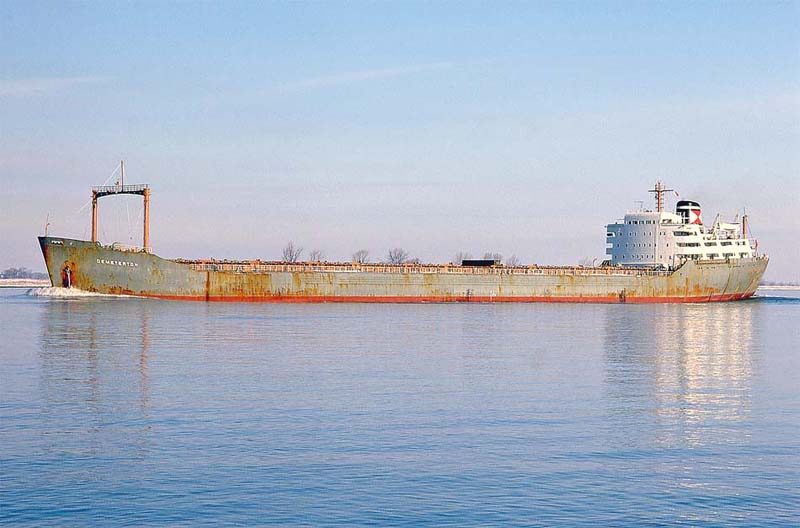
The first motorship entered the fleet in early 1954, the ‘Doxford Economy’ type Sutherland of 1940 being purchased from B. J. Sutherland & Co. Ltd. of Newcastle after the death of Sir Arthur Sutherland in 1953. She was traded for four years before her sale to Buries Markes Ltd. and renaming as La Bahia. Valuable experience of worldwide trading with new motortramps was then obtained from a septet of Wear built tramps.
The Seven Sisters
These were archetypal open shelterdeckers of 11,000 dwt and closed shelterdeckers of 12,575 dwt engaged on worldwide tramping for fifteen years from 1957 to 1972, being converted from open to closed shelterdeckers a few years after their completion. They were equally at home under the giant grain elevators at Rotterdam sucking out Texan grain from Galveston, or at Nagoya in Japan unloading soya bean pellets from Melbourne. There were also taken on charter by liner companies such as Ellerman Lines for their trades to India, South Africa and the Far East, and they, of course, tramped homeward from Rosario with grain to U.K. ports. They were powered by the dependable three cylinder Doxford oil engine of 3,150 bhp, providing a modest twelve knots when fully loaded to reach any port anywhere in the world. They had the old fashioned ‘split superstructure’ profile with number four hold between the navigating bridge and their domed, colourful funnels with the engineer’s accommodation at their base. This number four hold served in the earlier steam powered coal burning tramps as the ‘cross bunker’ hold full of coal to reach remote ports anywhere in the world to re-bunker. The septet had a goalpost mast and foremast forward, and mainmast aft and other posts to serve the six holds with a good array of derricks.
They all came from the yard of Short Brothers at Pallion adjacent to the famous Doxford yard on the south bank of the Wear and opposite the equally famous Southwick yard of Austin and Pickersgill Ltd. Lynton and Scorton were first in 1957, Grainton in 1958, Amberton and Norton in 1959, with Clearton launched by Mrs. Walter Woodward, wife of a director, on 16th November 1959 and made her maiden voyage in April 1960, and last but not least Brighton later in 1960. They had dimensions of length from 473.8 feet to 476.2 feet, moulded beam of 60.3 feet and a depth of a fraction under 26.0 feet. They had a loaded draft that enabled them to enter almost any port in the world.
There were, of course, marine accidents, with Grainton aground on 29th December 1963 on Royal Captain Shoal to the west of Palawan Island in the South China Sea, the reefs causing severe damage to her bow and number one hold. She was refloated 27 hours later but began sinking, with repairs put in hand by her crew sewing together several collision mats to place over the holes in order to make Manila at half speed. A new bow was fitted at Yokohama, and with a fresh coat of grey paint on her hull and red boot topping, she gave another six years of worldwide tramping e.g. from American and Caribbean ports to New Zealand and Australia returning home with a full cargo via Suez and the Mediterranean until sold off in 1970. Lynton spent three months in dry-dock at Nagoya after running aground while entering the port with a full cargo of soya bean pellets. Brighton stood by the ill fated Runic of Shaw, Savill and Albion Line when she ran aground on Middleton Reef on 19th February 1961 some 120 miles north of Lord Howe Island. Salvage tugs arrived and Brighton went on her way, but Runic stubbornly refused to refloat and her remains were visible for decades to come.
Three of these seven motor tramps were registered under a new company, Somerston Shipping Co. Ltd. of Hamilton (Bermuda), all of the shares being held by Ralph F. Chapman, the remaining four sisters were put under the ownership of the Carlton and Cambay companies. Clearton was sold off to Greeks in 1968, followed by Amberton in 1969, and Scorton, Grainton and Norton in 1970, leaving Lynton and Brighton to tramp all around the Far East, Australia, India, Malaya, Burma and Africa, as well as to beautiful Caribbean ports such as Port of Spain at Trinidad until both were sold off in late 1971/72. Their Tyneside crews enjoyed a good way of life that is so missing today for a generation of ‘would be’ seafarers.
A Liberian registered motor tramp of 12,050 dwt, Despina C built by Bartrams and completed in early 1956, was purchased at the end of 1960 and renamed Riverton when handed over in Japan on 31st January 1961. The two year old cargo-liner St. Rosario was purchased from the South American Saint Line of Cardiff in 1963 for £525,000 and renamed Hermiston and chartered out to liner companies for worldwide trading after handing over at Bremen on 21st October 1963. She replaced the last of the war built steam tramps that were sold off during that year. She traded for Chapman & Willan Ltd. for seven years before her sale to Greek owners after suffering severe bow damage in a collision off Greenock while inward bound to the James Watt Dock with sugar. The Greek owners got ten more years of trading from her before she capsized onto her side at Basrah during the bombing of the Iraq-Iran War.
The Albyn Line of Sunderland, managed by Allan, Black & Co. Ltd. since formation in 1901, was acquired in 1966 together with their last trio of tramps in Thistleroy, Thistledhu and Thistledowne sporting their black and white funnels bearing a black thistle. Thistledowne was the oldest of the trio and made only one voyage for Chapman & Willan in February 1966 when she ballasted to Recife in Brazil to load sugar for London. She was then sold to Indian owners who required a British registered vessel rather than the Bermudan registration of the Somerston Shipping Co. Ltd., so she was transferred to the ownership of the Carlton company just before her sale. Thistledhu was traded for two years of worldwide tramping for the company as Merton, while Thistleroy tramped for four years as Ingleton until sold in 1970.
Chapman and Willan Bulkers
The company had entered the bulk carrier era in February 1964 with the delivery of Carlton of 20,500 dwt from the Short Brothers yard and sadly the last of a long line from the yard for the company, and for the yard after 114 years of shipbuilding. She was designed by the hatch cover manufacturers MacGregor, and was known as a five hold ‘Universal Bulk Ship’, her principal difference being the provision of four upper holds at the junctions of the five main holds and with separate hatches and further divided longitudinally into three compartments. A total of seventeen compartments made the bulker eminently suitable for parcels of grain cargoes, especially loading homeward from the Plate. A near sister of 21,110 dwt was launched from one of the two slipways of the John Readhead yard at South Shields and completed in May 1967 as Demeterton. This pair of bulkers was lengthened at Amsterdam in 1968 to increase their deadweight by 4,000 tons to 24,710 dwt and make them more profitable.
A final bulker was purchased during fitting out at the Hakodate Dockyard in Japan in 1968 and was completed as Frumenton of 25,133 dwt. The fleet at the end of 1968 then stood at three bulkers and eight motortramps, with the bulkers mostly trading in the Far East, and the last of the motortramps sold off at the end of 1971. The high freight rates of the phosphate trade from Nauru to Melbourne, usually followed by soya bean pellets from Melbourne to Nagoya in Japan kept the company profitable until the decision was made to sell the fleet in 1974. The Burnett Steamship Co. Ltd. of Newcastle was operating in 1974 as a subsidiary of Fednav of Canada, and purchased the shares of Chapman & Willan Ltd. from the Somerston Shipping Co. Ltd. and thus acquired control of both the Carlton and Cambay companies. This severed all connection with Chapmans after 97 years of ownership. A management company was then set up in Newcastle as Burnett Chapman Ship Management and operated from the Burnett office in Milburn House to manage the bulkers Carlton and Demeterton as well as other bulkers and car carriers transferred from Fednav to Burnett ownership. Carlton continued to be traded from August 1974 until 7th January 1975, and was renamed Federal Wear on the following day until renamed as St. Lawrence Prospector on 11th March 1975. The near sister Demeterton was also renamed in March 1975 as St. Lawrence Navigator, Frumenton having been sold off in 1974 to Greek owners and renamed as Aegis Typhoon.
Postscript
The bulkers Carlton and Demeterton continued trading in the Great Lakes for four decades after the final demise of Chapman and Willan Ltd. They were fitted with 25 metre long cargo booms and conveyor belt gravity systems to operate as self unloaders, with new bows and a lengthening of their hulls to increase their deadweight to 30,325 dwt in 1979 with fifteen hatches serving three holds. They were renamed in 1979 as Canadian Prospector and Canadian Navigator respectively, with the former Carlton badly damaged in a collision in the Great Lakes in November 2002. She was repaired and traded in the Great Lakes for almost another decade before making the long Transatlantic voyage to a scrapyard in Aliaga in Turkey in November 2010. Demeterton was renamed in the Great Lakes as Algoma Navigator for the Algoma Corporation, her sale and renaming taking place in 2011, and is still sailing in the Great Lakes today as Navi, over fifty years since her maiden voyage. She is still powered by her original four cylinder two stroke Doxford oil engine of 9,680 bhp giving a service speed of fourteen knots. This concludes the story of one of the greatest Tyneside tramping companies, known throughout the world by their colourful red and white quartered houseflag on a black funnel between two thin white bands, although the quarters were more often orange than the original red. I knew several seafarers and office staff of Chapmans, sadly only a few are left alive today to remember the good times as they used to be.





Comments
Sorry, comments are closed for this item